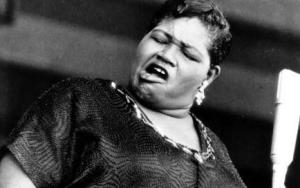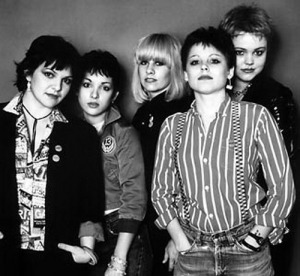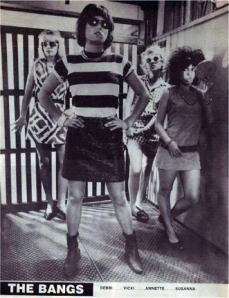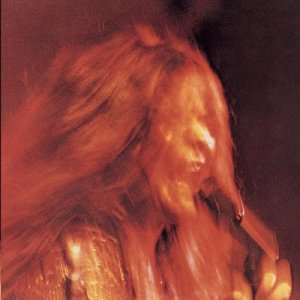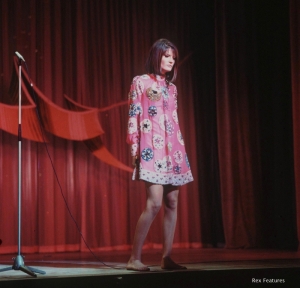“Am I only dreaming?”
 After signing with I.R.S. Records, The Go-Gos released their debut album, Beauty and the Beat, in 1981. A re-recorded version of “We Got the Beat” preceded the album, becoming a huge hit in the United States and Europe. The album went to #1 on the Billboard chart, becoming the first— and, to date, the only— album written and performed by an all-female band to reach that position. A second single from the album, “Our Lips Are Sealed”, became the band’s biggest hit later that year. Beauty and the Beat was a fine example of the New Wave sound, and the songs were consistently good. The band’s look, a hybrid of pop and punk, was fresh and exciting. Young girls around the world found inspiration in the story of five girls who joined together to conquer the pop universe.
After signing with I.R.S. Records, The Go-Gos released their debut album, Beauty and the Beat, in 1981. A re-recorded version of “We Got the Beat” preceded the album, becoming a huge hit in the United States and Europe. The album went to #1 on the Billboard chart, becoming the first— and, to date, the only— album written and performed by an all-female band to reach that position. A second single from the album, “Our Lips Are Sealed”, became the band’s biggest hit later that year. Beauty and the Beat was a fine example of the New Wave sound, and the songs were consistently good. The band’s look, a hybrid of pop and punk, was fresh and exciting. Young girls around the world found inspiration in the story of five girls who joined together to conquer the pop universe.
The crush of tour dates and personal appearances didn’t leave much time for the band to write the songs for their follow-up record, so when Vacation was released in 1982 the reviews were not as positive as those for Beauty and the Beat. The album and its title track both made the top 10, but failed to repeat the success of their earlier efforts. Band members were beginning to disagree more often, and drug use was becoming an issue for the band. They continued to tour, with great success, and took more time to work on their third album. Talk Show, released in 1984 to positive reviews, sold even less than Vacation. “Head Over Heels” just missed the top 10, despite its high quality. The strain within the group had reached unbearable levels, and Jane Wiedlin left the group in 1984. The other band members replaced her, but quickly realized that they did not want to continue on with the group. The Go-Gos officially disbanded in 1985, but it was not the end of their story.
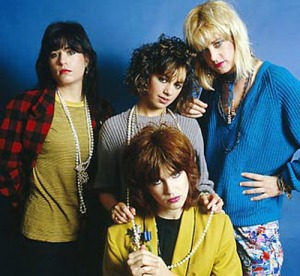 The Bangles’ career took a little longer to get started. After signing with Columbia, they released All Over the Place. The album received great reviews for its jangly pop sound (see “James”), and mixed covers of classic 60s songs with Bangles originals. The album was not a commercial success, peaking in the lower rungs of the charts, but it did win one very important fan: Prince. After hearing The Bangles, Prince became enamored of Susanna Hoffs; in an effort to meet her, he offered The Bangles a song called “Manic Monday”. The band released the song along with their second album, Different Light, in 1986. This album placed less emphasis on the band’s 1960s influence, although they still covered some classic songs. “Manic Monday” shot up the charts and into the top 5, while the album reached #2. A second single from Different Light, “Walk Like an Egyptian”, was released later that year and became a phenomenal success, topping the charts around the world.
The Bangles’ career took a little longer to get started. After signing with Columbia, they released All Over the Place. The album received great reviews for its jangly pop sound (see “James”), and mixed covers of classic 60s songs with Bangles originals. The album was not a commercial success, peaking in the lower rungs of the charts, but it did win one very important fan: Prince. After hearing The Bangles, Prince became enamored of Susanna Hoffs; in an effort to meet her, he offered The Bangles a song called “Manic Monday”. The band released the song along with their second album, Different Light, in 1986. This album placed less emphasis on the band’s 1960s influence, although they still covered some classic songs. “Manic Monday” shot up the charts and into the top 5, while the album reached #2. A second single from Different Light, “Walk Like an Egyptian”, was released later that year and became a phenomenal success, topping the charts around the world.
The next year, The Bangles scored again with a cover of Simon & Garfunkel’s “Hazy Shade of Winter”. Of all the Bangles’ singles, this one came closest to capturing their original sound, and it reached #2. In 1988, they released Everything. The album missed the top 10, but “In Your Room” was a top 5 hit, and “Eternal Flame” was a number one smash. With millions of young fans around the globe, many of them girls, the band was poised for even more success. Unfortunately, in-fighting and the record label’s elevation of Susanna Hoffs to lead singer status left some of the band members feeling neglected. It was all too much, and the band broke up…for the time being.
TO BE CONTINUED…
